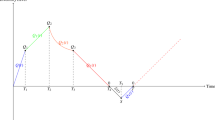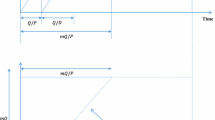Abstract
This paper considers a control wafers replenishment problem with inventory deterioration. In the process, control wafers begin to deteriorate after the pre-disposition. The objective of this research is to minimize the total cost of control wafers, where the cost includes ordering cost, holding cost and purchase cost. We first formulate the control wafers inventory problem as a dynamic programming model. We then transform the control wafers’ inventory problem into the mixed 0–1 linear programming model. An illustrative example with four cases is used to illustrate the practicality of these models, and sensitivity analysis is applied to understand the impact of parameters to these models. The results demonstrate that the proposed mixed 0–1 linear programming model is an effective tool for determining the replenishment of control wafers for multi-periods.
Similar content being viewed by others
References
Lin YL (2000) The design of inventory control model for dummy/control wafers at the furnace area in the wafer fab. Master thesis, National Chiao Tung University, Hsin-Chu, Taiwan (in Chinese)
Wong CY, Hood SJ (1994) Impact of process monitoring in semiconductor manufacturing. IEEE/CPMT International Electronics Manufacturing Technology Symposium, pp 221–225
Popovich SB, Chilton SR, Kilgore B (1997) Implementation of a test wafer inventory tracking system to increase efficiency in monitor wafer usage. IEEE/SEMI Advanced Semiconductor Manufacturing Conference, pp 440–443
Foster B, Meyersdorf D, Padillo JM, Brenner R (1998) Simulation of test wafer consumption in a semiconductor facility. IEEE/SEMI Advanced Semiconductor Manufacturing Conference, pp 298–302
Watanabe A, Kobayashi T, Egi T, Yoshida T (1999) Continuous and independent monitor wafer reduction in DRAM fab. IEEE International Symposium on Semiconductor Manufacturing Conference, pp 303–306
Savsar M (1997) Simulation analysis of a pull-push system for an electronic assembly line. Int J Prod Econ 51:205–214
Chen HC, Lee CE (2000) Downgrading management for control and dummy wafers. Journal of the Chinese Institute of Industrial Engineer 17(4):437–449
Chen HC, Lee CE (2003) Pull system for control and dummy wafers. Int J Adv Manuf Technol 22(11–12):805–818
Chen HC (2003) Control and dummy wafers management. Ph.D. thesis, National Chiao Tung University, Hsin-Chu, Taiwan
Hwang JN, Hwu TJ, Liao PY (2003) A study to enhance the economic efficiency of control and dummy wafers. Chinese Institute of Industrial Engineers Conference, Changhua, Taiwan (in Chinese)
Chung SH, Lee AHI, Lai CW (2004) Single loop management system for control wafers in the wafer fabrication. J Quant Manage 1(1):1–12 (in Chinese)
Chung SH, Kang HY, Pearn WL (2005a) A service level model for the control wafers safety inventory problem. Int J Adv Manuf Technol 26:591–597
Chung SH, Pearn WL, Kang HY (2005b) A linear programming model for the control wafers downgrading problem. Int J Adv Manuf Technol 25(3):377–384
Chung SH, Pearn WL, Kang HY (2005c) Control wafers inventory management in the wafer fabrication photolithography area. Prod Plan Control 16(3):286–296
Wu M-C, Chien CS, Lu KS (2005) Downgrade decision for control/dummy wafers in a fab. Int J Adv Manuf Technol 26:585–590
Ghare PM, Schrader SF (1963) A model for exponentially decaying inventory. J Ind Eng 14:238–243
Spiegel MR (1960) Applied differential equation. Prentice-Hall, Englewood Cliffs
Covert RP, Philip GC (1973) An EOQ model for items with Weibull distribution deterioration. AIIE Trans 5:323–326
Mak KL (1982) A production lot size inventory model for deteriorating items. Computers and Industrial Engineering 6:309–317
Kang S, Kim I (1983) A study on the price and production level of the deteriorating inventory system. Int J Prod Res 21:449–460
Heng KJ, Labban J, Linn RL (1991) An order-level lot-size inventory model for deteriorating items with finite replenishment rate. Computers and Industrial Engineering 20:187–197
Yan H, Cheng TCE (1998) Optimal production stopping and restarting times for an EOQ model with deteriorating items. J Oper Res Soc 49:1288–1295
Raafat F (1991) Survey of literature on continuously deteriorating inventory models. J Oper Res Soc 42:27–37
Goyal SK, Giri BC (2001) Recent trends in modeling of deteriorating inventory. Eur J Oper Res 134:1–16
Su C-T, Lin C-W (2001) A production inventory model which considers the dependence of production rate on demand and inventory level. Prod Plan Control 12(1):69–75
Chang HJ, Hung CH, Dye CY (2002) A finite time horizon inventory model with deterioration and time-value of money under the conditions of permissible delay in payments. Int J Syst Sci 33(2):141–151
Rau H, Wu M-Y, Wee H-M (2003) Integrated inventory model for deteriorating items under a multi-echelon supply chain environment. Int J Prod Econ 86:155–168
Yang P-C, Wee H-M (2003) An integrated multi-lot-size production inventory model for deteriorating item. Comput Oper Res 30:671–682
Sana S, Goyal SK, Chaudhuri KS (2004) A production-inventory model for a deteriorating item with trended demand and shortages. Eur J Oper Res 157:357–371
Chen JM, Chen LT (2005) Pricing and production lot-size/scheduling with finite capacity for a deteriorating item over a finite horizon. Comput Oper Res 32:2801–2819
Dye C-Y, Chang H-J, Teng J-T (2006) A deteriorating inventory model with time-varying demand and shortage-dependent partial backlogging. Eur J Oper Res 172:417–429
Hou KL (2006) An inventory model for deteriorating items with stock-dependent consumption rate and shortages under inflation and time discounting. Eur J Oper Res 168:463–474
Wee H-M, Shum Y-S (1999) Model development for deteriorating inventory in material requirement planning systems. Comput Ind Eng 36:219–225
Chiang C (2001) A note on optimal policies for a periodic inventory system with emergency orders. Comput Oper Res 28:93–103
Kuo Y (2006) Optimal adaptive control policy for joint machine maintenance and product quality control. Eur J Oper Res 171:586–597
Chang CT, Chang CC (2000) A linearization method for mixed 0–1 polynomial programs. Comput Oper Res 27:1005–1016
Lee SM, Asllani AA (2004) Job scheduling with dual criteria and sequence-dependent setups: mathematical versus genetic programming. Omega 32:145–153
Kozanidis G, Melachrinoudis E (2004) A branch & bound algorithm for the 0–1 mixed integer knapsack problem with linear multiple choice constraints. Comput Oper Res 31:695–711
Glover F (2006) Parametric tabu-search for mixed integer programs. Comput Oper Res 33:2449–2494
Author information
Authors and Affiliations
Corresponding author
Rights and permissions
About this article
Cite this article
Kang, HY. Optimal replenishment policies for deteriorating control wafers inventory. Int J Adv Manuf Technol 35, 736–744 (2008). https://doi.org/10.1007/s00170-006-0750-9
Received:
Accepted:
Published:
Issue Date:
DOI: https://doi.org/10.1007/s00170-006-0750-9




